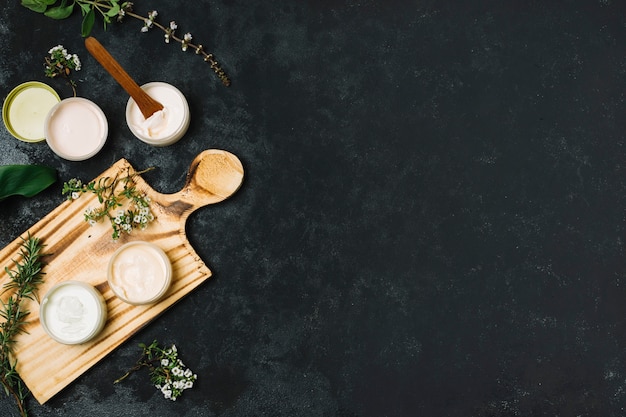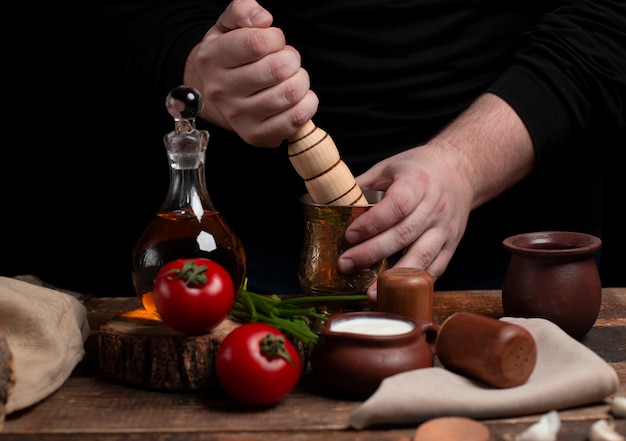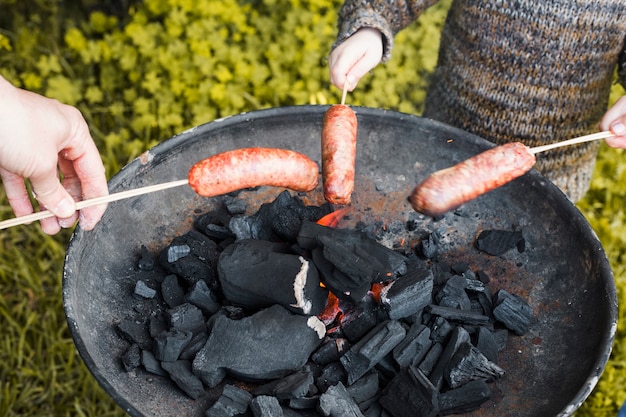Alright, you've finally got your hands on a brand spanking new blackstone griddle, and you're eager to get grilling, right? But hold your horses, my friend! Before you even think about tossing a burger onto that gleaming surface, you absolutely need to give it a proper seasoning. It's like giving your trusty frying pan a good armor-plating - it'll protect it, make it non-stick, and keep it looking spiffy for years to come.
Now, I'm no culinary wizard, but I've learned a thing or two about seasoning my Blackstone over the years. I've had my fair share of burnt-on messes, and let me tell you, it's a right pain to clean! But after a few (okay, maybe a lot!) of trial and error, I've cracked the code.
So, sit back, grab a cuppa, and let me walk you through the entire process. This guide is going to cover everything from the basics to some handy tips and tricks, making sure your Blackstone is ready to rock for all your grilling adventures.
Part 1: Understanding Seasoning

Why Season a Blackstone Griddle?
Seasoning a Blackstone is all about creating a protective layer, a sort of invisible shield against sticking and rust. It's essentially about creating a thin layer of polymerized oil on the surface, which acts as a non-stick coating. This makes cooking a breeze, helps you avoid burnt-on food, and keeps your griddle looking shiny and new. Plus, a well-seasoned griddle just feels nicer to cook on, trust me!
What Happens if You Don't Season Your Blackstone?
You might be tempted to skip the whole seasoning thing and jump straight into grilling. But, I'm telling you, it's a bad idea! If you don't season your Blackstone, you're going to be dealing with a sticky, burnt-on mess that's a real nightmare to clean. Plus, you're more likely to scratch the surface, which can lead to rust and eventually damage your griddle. It's like trying to cook on a bare metal pan - not a pleasant experience!
What's the Best Oil to Use?
When it comes to seasoning, you want to use an oil with a high smoke point. This means it can handle the heat of your griddle without breaking down and turning into smoke. My go-to is canola oil, as it's relatively inexpensive and does the job perfectly. Here's a table with some other good options and their smoke points:
| Oil | Smoke Point (°F) | Suitable for Seasoning |
|---|---|---|
| Canola | 400°F | Yes |
| Avocado | 520°F | Yes |
| Grapeseed | 420°F | Yes |
| Olive Oil | 374°F | Not Recommended |
| Peanut | 450°F | Yes |
Remember, olive oil isn't ideal for seasoning because it has a lower smoke point. It might start to burn before it forms a good layer on your griddle.
Part 2: Getting Ready to Season

Cleaning Your Blackstone
First things first, you need to give your griddle a thorough clean. Wipe down the surface with a damp cloth and a mild dish soap. Make sure you remove any dust, debris, or residue left from the factory. Once it's clean, dry it thoroughly with a paper towel or a clean cloth. You want your griddle to be sparkling clean before you start seasoning.
Heating Your Blackstone
Now, get your Blackstone fired up to medium heat. You want the surface to be hot enough for the oil to start to polymerize, but not so hot that it starts to smoke heavily. I usually aim for around 350-400°F (175-200°C). If your Blackstone has a built-in thermometer, it's super handy for keeping track of the temperature. You don't want to scorch the surface, just get it nice and warm.
Applying Oil
With your griddle hot, grab a clean paper towel or a cloth and pour a small amount of your chosen oil onto it. Now, use the oil-soaked paper towel to rub the oil all over the surface of the griddle. Make sure you cover the entire cooking surface, even the edges and corners. I find it's helpful to use a good amount of oil, especially for the first few seasoning sessions. You want a nice even coating.
Part 3: The Seasoning Process

First Seasoning
This is where the magic happens! You're going to let the oil heat up on the griddle for about 10 minutes or so. You'll notice the oil starts to smoke a little, and that's completely normal. The smoke is just the oil polymerizing and forming that protective layer. Don't worry, it shouldn't be too much smoke. It's just a sign that the oil is doing its job.
Wipe and Repeat
After about 10 minutes, turn off the heat and let the griddle cool down for a bit. Then, use a clean paper towel to wipe off any excess oil. You'll see a nice, shiny, almost black layer of oil left on the surface. This is your seasoning layer! You might need to repeat this process a few times, especially for the first seasoning, to build up that layer. Be patient, it takes time to build a solid seasoning.
Final Step: Burn Off Excess Oil
Once you've done a couple of rounds of oiling and wiping, it's time to burn off any excess oil. Turn the heat back up to high for a few minutes, just until the surface is really hot. This will burn off any remaining oil and give you a nice, smooth finish. You'll be left with a beautifully seasoned surface ready for your first grilling session.
Part 4: Maintaining Your Seasoned Blackstone
Right, so you've got your Blackstone all seasoned up and ready to go. But the work isn't over yet! You need to keep that seasoning going to keep your griddle in tip-top shape.
Post-Cook Cleaning
After each use, give your griddle a quick clean. Let it cool down, then use a scraper to remove any leftover food. Then, wipe it down with a damp cloth and mild dish soap. You don't need to scrub too hard, just give it a gentle clean. Make sure you dry it completely.
Keep It Seasoned
To keep that seasoning nice and strong, you'll want to give it a quick oiling after each use. Turn the heat up to medium, let the surface get nice and hot, then apply a thin layer of oil with a paper towel. Wipe off any excess and let it cool down. That's it! Just a quick refresh to keep your griddle in top shape.
Don't Use Harsh Cleaners
Avoid using harsh cleaners or abrasive sponges on your Blackstone. They can strip away the seasoning and damage the surface. Stick to mild dish soap and a soft cloth for cleaning. You want to treat your Blackstone like a delicate piece of cookware.
Part 5: Dealing with Sticking and Burnt-On Food
Let's face it, even with a well-seasoned Blackstone, you might still end up with some sticking or burnt-on food. Don't panic! There are a few tricks to help you deal with it.
Cleaning with a Scraper
If you get some sticking, use a metal scraper to remove the food. Just be careful not to scratch the surface too much. You can also try using a wooden spatula to gently pry up any stubborn bits.
The Salt Method
For stubborn burnt-on food, try the salt method. Sprinkle a generous amount of salt over the burnt area and let it sit for a few minutes. The salt will help absorb the burnt residue. Then, use a scraper to scrape off the salt and burnt food.
Don't Over-Scrub
Just like with regular cleaning, avoid scrubbing too hard. You don't want to damage the seasoning or scratch the surface. If you're struggling with a really stubborn burnt-on mess, try soaking it in warm water for a while to loosen it up.
Part 6: Common Seasoning Mistakes
Everyone makes mistakes, even seasoned Blackstone griddle pros! So here are a few common mistakes to avoid:
Using Too Much Oil
A common mistake is using too much oil. You only need a thin layer to create a good seasoning. Too much oil can lead to smoke and a gummy mess. Less is more when it comes to seasoning oil.
Not Letting the Oil Heat Up
If you don't let the oil heat up properly, it won't polymerize and form a good seasoning. Make sure the surface is hot enough before applying the oil. Give it a good warm-up!
Cleaning With Harsh Cleaners
As I mentioned before, avoid using harsh cleaners on your Blackstone. They can strip away the seasoning and damage the surface. Stick to simple, gentle cleaning methods.
Neglecting to Re-season
Don't forget to re-season your Blackstone after each use. Even a quick oiling will help keep that seasoning strong and prevent sticking. It's a small step that makes a big difference.
Part 7: Tips and Tricks for Seasoning Success
Here are a few extra tips to help you get the best seasoning:
Use a Non-Stick Spray
If you're really worried about sticking, you can use a non-stick spray on your Blackstone before cooking. Just be sure to use a spray designed for high heat and avoid using too much. It's a good backup for those extra-sticky foods.
Cook on Low Heat
If you're new to using a Blackstone, start off cooking on low heat. It'll give you more time to adjust to the cooking surface and reduce the risk of burning your food. It's better to be safe than sorry!
Experiment with Seasonings
You can experiment with different oils and seasoning methods. Some people like to use flaxseed oil or even a mixture of oils for a different flavor and texture. Just make sure you use an oil with a high smoke point. Don't be afraid to try new things, but always prioritize a high smoke point.
Don't Be Afraid to Start Over
If your seasoning starts to get damaged or worn, don't be afraid to start over. Just give your Blackstone a good clean and follow the seasoning steps again. It's a good practice to give your griddle a fresh start if needed.
Part 8: FAQs
Q: How often should I season my Blackstone?
You should season your Blackstone after each use. It doesn't have to be a full-blown seasoning session every time. A quick oiling with a paper towel after cleaning is usually enough. Think of it as a quick refresh.
Q: What's the best way to clean a burnt-on mess on my Blackstone?
For burnt-on food, I recommend the salt method. Sprinkle salt over the burnt area, let it sit for a few minutes, then scrape it off with a metal scraper. You can also try soaking the burnt area in warm water to loosen up the residue. It's a tried-and-true method for those stubborn messes.
Q: Can I use my Blackstone indoors?
I wouldn't recommend using your Blackstone indoors unless you have excellent ventilation. It's designed for outdoor use and can produce a lot of smoke and heat. It's best to enjoy the fresh air and grilling experience outdoors.
Q: Can I season my Blackstone with olive oil?
I wouldn't recommend using olive oil for seasoning. It has a lower smoke point and might start to burn before it forms a good layer on your Blackstone. Stick to oils with higher smoke points for best results.
Q: What's the best way to store my Blackstone?
If you're storing your Blackstone for a long period, make sure it's clean and dry. You can cover it with a Blackstone cover to protect it from dust and the elements. It's good practice to give it a proper rest when not in use.
There you have it, my fellow griddle enthusiasts! Seasoning your Blackstone is a crucial step in keeping it in top condition. It's a bit of an art, but with a little practice, you'll be a pro in no time. So, get grilling, enjoy those delicious meals, and remember to keep that seasoning game strong!
Everyone is watching

Corn on the Cob: The Ultimate Guide to Perfectly Cooked Ears
Healthy MealsAh, corn on the cob. Just the name evokes images of sunny days, barbecues, and that sweet, juicy flavour that ...

Perfect Pork Roast Oven Cooking Time: A Guide to Delicious Results
Healthy MealsThere's something truly satisfying about a perfectly roasted pork. The aroma alone is enough to make your mout...

Ham Cooking Time: How Long to Bake, Smoke, or Boil a Delicious Ham
Healthy MealsAh, ham. It's a classic, isn't it? A real crowd-pleaser, especially around holidays. And when done right, it'...

Scallops: The Ultimate Guide to Perfect Cooking
Healthy MealsAh, scallops. Those delicate, sweet, and utterly delicious morsels of the sea. They hold a special place in my...

Spaghetti Squash: The Ultimate Guide to Cooking and Serving
Healthy MealsRemember that time you saw spaghetti squash at the supermarket, looking all bumpy and strange, and thought, "W...
